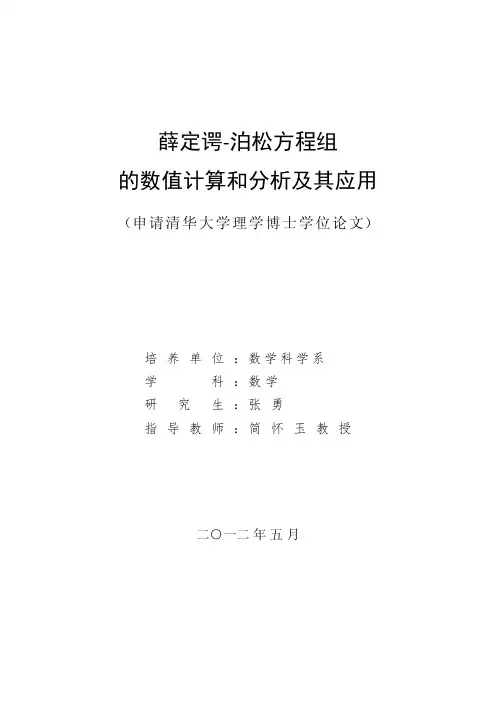Homotopy Perturbation Sumudu Transform Method
- 格式:pdf
- 大小:90.00 KB
- 文档页数:11
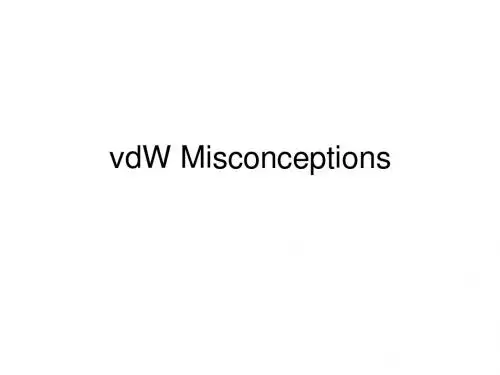

中国科学技术大学硕士学位论文一般状态方程多流体界面数值方法研究姓名:郑建国申请学位级别:硕士专业:流体力学指导教师:孙德军;尹协远20050501中文摘要摘要①本文发展了一类一般状态方程可压缩多流体界面的数值模拟方法,并具体应用到三种不同的非理想气体状态方程,包括sti&nf刚性)气体状态方程,varlderWaals状态方程以及工程上广泛适用的更一般的Mie—Griineisen状态方程。
此方法主要的特点是:f1).采用体积分数多流体数学模型,这是在假设多流体交界面两侧压力和速度平衡的基础上根据二相流理论建立的,并引入计算混合流体压力的“状态方程”使系统封闭。
(2).将高精度、高分辨率的PiecewiseParabolicMethod(PPM)数值方法推广到多流体问题中,用膨胀激波代替稀琉波,采用双波近似的方法求解多流体Riemann问题。
(3).使用Lagrangian-Remapping两步法求解模型方程组。
与以往的多流体方法相比,本文的方法具有一些优点。
首先,体积分数多流体数学模型所采用的交界面两侧压力和速度平衡的假设与真实的物理情况比较接近,它消除了交界面上压力的振荡;特别是其模型简单,并且不因为具体的状态方程而改变,便于应用到复杂状态方程的多流体流动问题。
其次,文中推广的多流体PPM方法处理交界面问题的效果非常好,它继承了原始PPM的高分辨率和能有效抑制间断上压力振荡的优点。
最后,Lagrangian—Remapping形式的PPM方法具有Lagrange类方法的特点,它可以有效地处理多流体界面,为了验证方法是否合理有效,进行了大量的数值实验。
一维和二维算例表明本文的方法可以有效地处理一般状态方程的接触间断、激波、激波和接触间断的相互作用以及多维滑移线等物理问题。
从数值结果中可以很明显地看出交界面附近压力无振荡,并能够比其它一般多流体数值方法更糟细地模拟多流体交界面。
本文还研究了柱坐标下内聚激波诱导的Pdchtmyer—MeshkovInstability(RMt)e从模拟的结果来看,演化过程中出现的钉状(spike)和泡状(bubble)结构以及后期的蘑菇状交界面都很清晰。
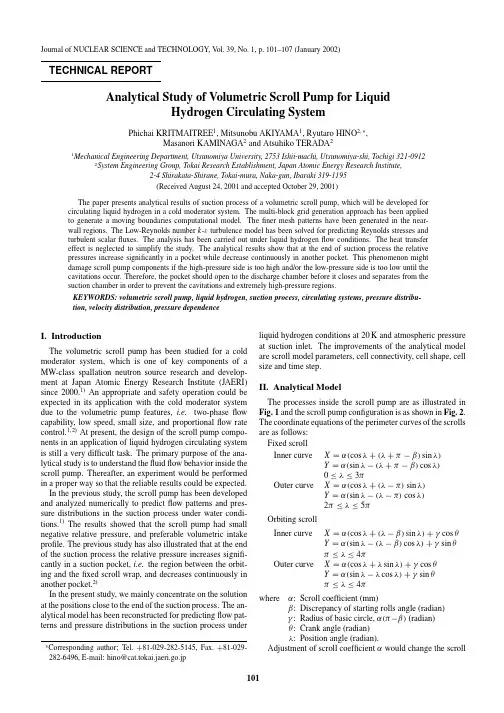

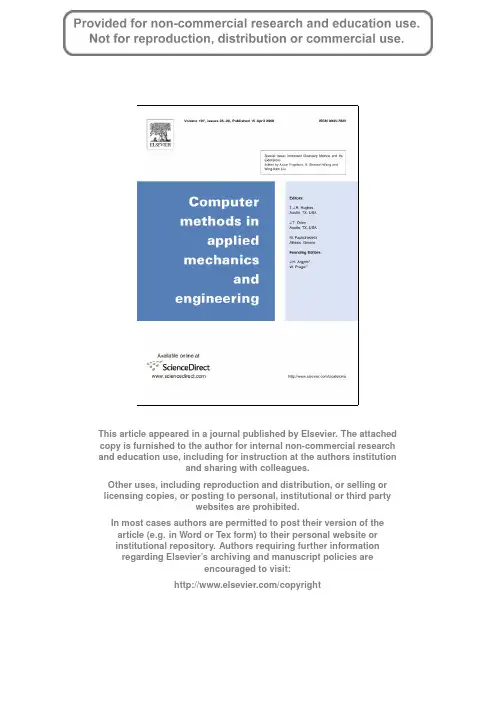
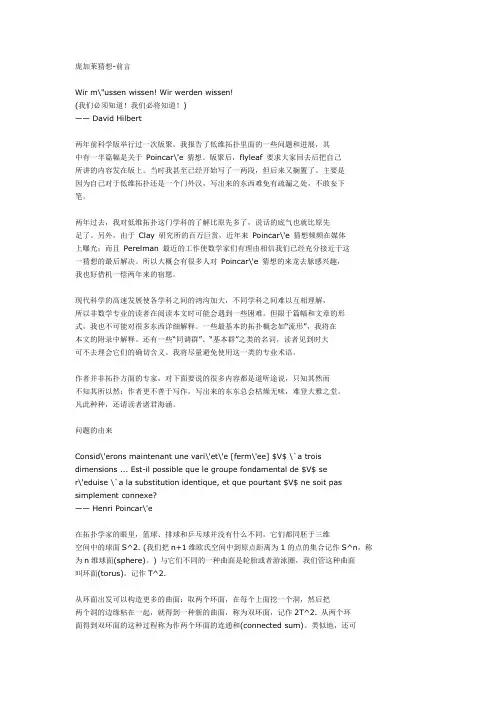
庞加莱猜想-前言Wir m\"ussen wissen! Wir werden wissen!(我们必须知道!我们必将知道!)—— David Hilbert两年前科学版举行过一次版聚,我报告了低维拓扑里面的一些问题和进展,其中有一半篇幅是关于Poincar\'e 猜想。
版聚后,flyleaf 要求大家回去后把自己所讲的内容发在版上。
当时我甚至已经开始写了一两段,但后来又搁置了。
主要是因为自己对于低维拓扑还是一个门外汉,写出来的东西难免有疏漏之处,不敢妄下笔。
两年过去,我对低维拓扑这门学科的了解比原先多了,说话的底气也就比原先足了。
另外,由于Clay 研究所的百万巨赏,近年来Poincar\'e 猜想频频在媒体上曝光;而且Perelman 最近的工作使数学家们有理由相信我们已经充分接近于这一猜想的最后解决。
所以大概会有很多人对Poincar\'e 猜想的来龙去脉感兴趣,我也好借机一偿两年来的宿愿。
现代科学的高速发展使各学科之间的鸿沟加大,不同学科之间难以互相理解,所以非数学专业的读者在阅读本文时可能会遇到一些困难。
但限于篇幅和文章的形式,我也不可能对很多东西详细解释。
一些最基本的拓扑概念如“流形”,我将在本文的附录中解释。
还有一些“同调群”、“基本群”之类的名词,读者见到时大可不去理会它们的确切含义。
我将尽量避免使用这一类的专业术语。
作者并非拓扑方面的专家,对下面要说的很多内容都是道听途说,只知其然而不知其所以然;作者更不善于写作,写出来的东东总会枯燥无味,难登大雅之堂。
凡此种种,还请读者诸君海涵。
问题的由来Consid\'erons maintenant une vari\'et\'e [ferm\'ee] $V$ \`a trois dimensions ... Est-il possible que le groupe fondamental de $V$ ser\'eduise \`a la substitution identique, et que pourtant $V$ ne soit pas simplement connexe?—— Henri Poincar\'e在拓扑学家的眼里,篮球、排球和乒乓球并没有什么不同,它们都同胚于三维空间中的球面S^2. (我们把n+1维欧氏空间中到原点距离为1的点的集合记作S^n,称为n维球面(sphere)。

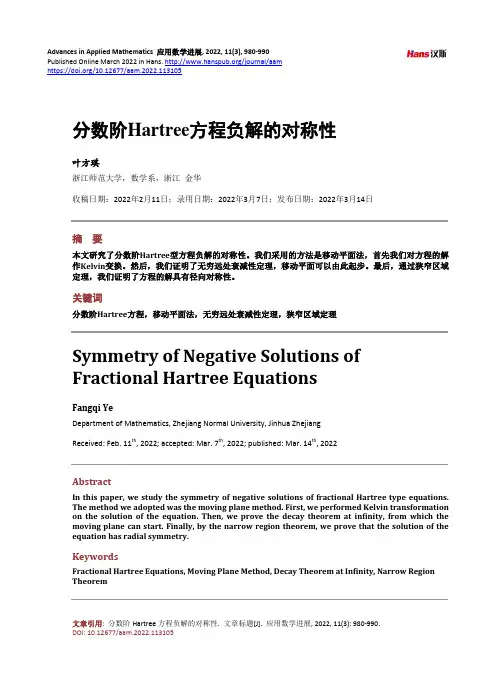
Advances in Applied Mathematics 应用数学进展, 2022, 11(3), 980-990Published Online March 2022 in Hans. /journal/aamhttps:///10.12677/aam.2022.113105分数阶Hartree方程负解的对称性叶方琪浙江师范大学,数学系,浙江金华收稿日期:2022年2月11日;录用日期:2022年3月7日;发布日期:2022年3月14日摘要本文研究了分数阶Hartree型方程负解的对称性。
我们采用的方法是移动平面法,首先我们对方程的解作Kelvin变换。
然后,我们证明了无穷远处衰减性定理,移动平面可以由此起步。
最后,通过狭窄区域定理,我们证明了方程的解具有径向对称性。
关键词分数阶Hartree方程,移动平面法,无穷远处衰减性定理,狭窄区域定理Symmetry of Negative Solutions ofFractional Hartree EquationsFangqi YeDepartment of Mathematics, Zhejiang Normal University, Jinhua ZhejiangReceived: Feb. 11th, 2022; accepted: Mar. 7th, 2022; published: Mar. 14th, 2022AbstractIn this paper, we study the symmetry of negative solutions of fractional Hartree type equations.The method we adopted was the moving plane method. First, we performed Kelvin transformation on the solution of the equation. Then, we prove the decay theorem at infinity, from which the moving plane can start. Finally, by the narrow region theorem, we prove that the solution of the equation has radial symmetry.KeywordsFractional Hartree Equations, Moving Plane Method, Decay Theorem at Infinity, Narrow Region Theorem叶方琪Copyright © 2022 by author(s) and Hans Publishers Inc.This work is licensed under the Creative Commons Attribution International License (CC BY 4.0)./licenses/by/4.0/1. 引言在本文中,我们主要考虑下列分数阶静态Hartree 方程()()()()()1,11,,,,p sn q nnloc s u x u x u x x x u C L x σ−∆=∗∈∈∈(1) 其中()0u x <,01s <<,04q s ≤≤,{}max 2,n s q >,22n q p n s −=−,212n s qn sσ+−≤≤−,σ为奇数并且 ()()2::|d .1n n n s n su x L u x x +=→<∞ +∫ 分数阶拉普拉斯算子定义为(见[1] [2])()()()(),2..d .nsn s n su x u y u x C PVy x y+−−∆=−∫ (2)Hartree 型方程在非相对论玻色子原子和分子大系统的量子理论中有许多有趣的应用,事实上,Hartree 型方程是在研究这类系统的平均场极限时产生的,即在玻色子数量非常大,但它们之间的相互作用很弱的情况下,因此,通过数学方法研究Hartree 型方程有重要意义,参见文献[3]-[8]及其引用的参考文献。
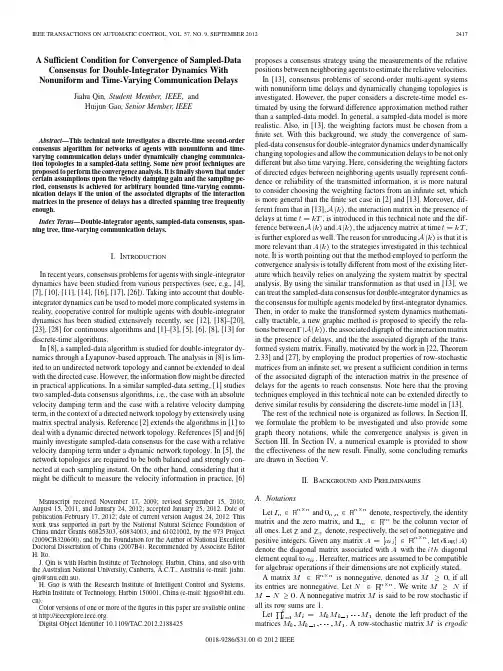
A Sufficient Condition for Convergence of Sampled-DataConsensus for Double-Integrator Dynamics With Nonuniform and Time-Varying Communication Delays Jiahu Qin,Student Member,IEEE,andHuijun Gao,Senior Member,IEEEAbstract—This technical note investigates a discrete-time second-order consensus algorithm for networks of agents with nonuniform and time-varying communication delays under dynamically changing communica-tion topologies in a sampled-data setting.Some new proof techniques are proposed to perform the convergence analysis.It isfinally shown that under certain assumptions upon the velocity damping gain and the sampling pe-riod,consensus is achieved for arbitrary bounded time-varying commu-nication delays if the union of the associated digraphs of the interaction matrices in the presence of delays has a directed spanning tree frequently enough.Index Terms—Double-integrator agents,sampled-data consensus,span-ning tree,time-varying communication delays.I.I NTRODUCTIONIn recent years,consensus problems for agents with single-integrator dynamics have been studied from various perspectives(see,e.g.,[4], [7],[10],[11],[14],[16],[17],[26]).Taking into account that double-integrator dynamics can be used to model more complicated systems in reality,cooperative control for multiple agents with double-integrator dynamics has been studied extensively recently,see[12],[18]–[20], [23],[28]for continuous algorithms and[1]–[3],[5],[6],[8],[13]for discrete-time algorithms.In[8],a sampled-data algorithm is studied for double-integrator dy-namics through a Lyapunov-based approach.The analysis in[8]is lim-ited to an undirected network topology and cannot be extended to deal with the directed case.However,the informationflow might be directed in practical applications.In a similar sampled-data setting,[1]studies two sampled-data consensus algorithms,i.e.,the case with an absolute velocity damping term and the case with a relative velocity damping term,in the context of a directed network topology by extensively using matrix spectral analysis.Reference[2]extends the algorithms in[1]to deal with a dynamic directed network topology.References[5]and[6] mainly investigate sampled-data consensus for the case with a relative velocity damping term under a dynamic network topology.In[5],the network topologies are required to be both balanced and strongly con-nected at each sampling instant.On the other hand,considering that it might be difficult to measure the velocity information in practice,[6] Manuscript received November17,2009;revised September15,2010; August15,2011,and January24,2012;accepted January25,2012.Date of publication February17,2012;date of current version August24,2012.This work was supported in part by the National Natural Science Foundation of China under Grants60825303,60834003,and61021002,by the973Project (2009CB320600),and by the Foundation for the Author of National Excellent Doctoral Dissertation of China(2007B4).Recommended by Associate Editor H.Ito.J.Qin is with Harbin Institute of Technology,Harbin,China,and also with the Australian National University,Canberra,A.C.T.,Australia(e-mail:jiahu. qin@.au).H.Gao is with the Research Institute of Intelligent Control and Systems, Harbin Institute of Technology,Harbin150001,China(e-mail:hjgao@. cn).Color versions of one or more of thefigures in this paper are available online at .Digital Object Identifier10.1109/TAC.2012.2188425proposes a consensus strategy using the measurements of the relative positions between neighboring agents to estimate the relative velocities. In[13],consensus problems of second-order multi-agent systems with nonuniform time delays and dynamically changing topologies is investigated.However,the paper considers a discrete-time model es-timated by using the forward difference approximation method rather than a sampled-data model.In general,a sampled-data model is more realistic.Also,in[13],the weighting factors must be chosen from a finite set.With this background,we study the convergence of sam-pled-data consensus for double-integrator dynamics under dynamically changing topologies and allow the communication delays to be not only different but also time varying.Here,considering the weighting factors of directed edges between neighboring agents usually represent confi-dence or reliability of the transmitted information,it is more natural to consider choosing the weighting factors from an infinite set,which is more general than thefinite set case in[2]and[13].Moreover,dif-ferent from that in[13],A(k),the interaction matrix in the presence of delays at time t=kT,is introduced in this technical note and the dif-ference between A(k)and A(k),the adjacency matrix at time t=kT, is further explored as well.The reason for introducing A(k)is that it is more relevant than A(k)to the strategies investigated in this technical note.It is worth pointing out that the method employed to perform the convergence analysis is totally different from most of the existing liter-ature which heavily relies on analyzing the system matrix by spectral analysis.By using the similar transformation as that used in[13],we can treat the sampled-data consensus for double-integrator dynamics as the consensus for multiple agents modeled byfirst-integrator dynamics. Then,in order to make the transformed system dynamics mathemati-cally tractable,a new graphic method is proposed to specify the rela-tions between0(A(k)),the associated digraph of the interaction matrix in the presence of delays,and the the associated digraph of the trans-formed system matrix.Finally,motivated by the work in[22,Theorem 2.33]and[27],by employing the product properties of row-stochastic matrices from an infinite set,we present a sufficient condition in terms of the associated digraph of the interaction matrix in the presence of delays for the agents to reach consensus.Note here that the proving techniques employed in this technical note can be extended directly to derive similar results by considering the discrete-time model in[13]. The rest of the technical note is organized as follows.In Section II, we formulate the problem to be investigated and also provide some graph theory notations,while the convergence analysis is given in Section III.In Section IV,a numerical example is provided to show the effectiveness of the new result.Finally,some concluding remarks are drawn in Section V.II.B ACKGROUND AND P RELIMINARIESA.NotationsLet I n2n2n and0n;n2n2n denote,respectively,the identity matrix and the zero matrix,and1m2m be the column vector of all ones.Letand+denote,respectively,the set of nonnegative and positive integers.Given any matrix A=[a ij]2n2n,let diag(A) denote the diagonal matrix associated with A with the ith diagonal element equal to a ii.Hereafter,matrices are assumed to be compatible for algebraic operations if their dimensions are not explicitly stated.A matrix M2n2n is nonnegative,denoted as M 0,if all its entries are nonnegative.Let N2n2n.We write M N if M0N 0.A nonnegative matrix M is said to be row stochastic if all its row sums are1.Let k i=1M i=M k M k01111M1denote the left product of the matrices M k;M k01;111;M1.A row-stochastic matrix M is ergodic0018-9286/$31.00©2012IEEE(or indecomposable and aperiodic )if there exists a column vector f2nsuch that lim k !1M k =1n f T .B.Graph Theory NotationsLet G =(V ;E ;A )be a weighted digraph of order n with a finite nonempty set of nodes V =f 1;2;...;n g ,a set of edges E V 2V ,and a weighted adjacency matrix A =[a ij ]2n 2n with nonnegative adjacency elements a ij .An edge of G is denoted by (i;j ),meaning that there is a communication channel from agent i to agent j .The adjacency elements associated with the edges are positive,i.e.,(j;i )2E ,a ij >0.Moreover,we assume a ii =0for all i 2V .The set of neighbors of node i is denoted by N i =f j 2V :(j;i )2Eg .Denote by L =[l ij ]the Laplacian matrix associated with G ,where l ij =0a ij ,i =j ,and l ii=n k =1;k =i a ik .A directed path is a sequence of edges in a digraph of the form (i 1;i 2);(i 2;i 3);....A digraph has a directed spanning tree if there exists at least one node,called the root node,having a directed path to all the other nodes.A spanning subgraph G s of a directed graph G is a directed graph such that the node set V (G s )=V (G )and the edge set E (G s ) E (G ).Given a nonnegative matrix S =[s ij ]2n 2n ,the associated di-graph of S ,denoted by 0(S ),is the directed graph with the node set V =f 1;2;...;n g such that there is an edge in 0(S )from j to i if and only if s ij >0.Note that for arbitrary nonnegative matrices M;N2p 2p satisfying M N ,where >0,if 0(N )has a di-rected spanning tree,then 0(M )also has a directed spanning tree.C.Sampled-Data Consensus Algorithm for Double-Integrator DynamicsEach agent is regarded as a node in a digraph G of order n .Let T >0denote the sampling period and k2denote the discrete-time index.For notational simplicity,the sampling period T will be dropped in the sequel when it is clear from the context.We consider the following sampled-data discrete-time system which has been investigated in [1],[2],and [8]asr i (k +1)0r i (k )=T v i (k )+12T 2u i (k )v i (k +1)0v i (k )=T u i (k )(1)where x i (k )2p ,v i (k )2p and u i (k )2p are,respectively,the position,velocity and control input of agent i at time t =kT .For simplicity,we assume p =1.However,all results still hold for any p2+by introducing the notation of Kronecker product.In this technical note,we mainly consider the following discrete-time second-order consensus algorithm which takes into account the nonuniform and time-varying communication delays as u i (k )=0 v i (k )+j 2N (k )ij (k )(r j (k 0 ij (k ))0r i (k ))(2)where >0denotes the absolute velocity damping gain,N i (k )de-notes the neighbor set of agent i at time t =kT that varies with G (k )(i.e.,the dynamic communication topology at time t =kT ), ij (k )>0if agent i can receive the delayed position r j (k 0 ij (k ))from agent j at time t =kT while ij (k )=0otherwise,and 0 ij (k ) max ,where ij (k )2,is the communication delay from agent j to agent i .Here,we assume ii (t ) 0,that is,the time delays affect only the in-formation that is transmitted from one agent to another.Moreover,we assume that all the nonzero and hence positive weighting factors areboth uniformly lower and upper bounded,i.e., ij (k )2[ ;],where 0< < ,if j 2N i (k ).Remark 1:In general,(j;i )2E (G (k ))or a ij (k )>0,which cor-responds to an available communication channel from agent j to agent i at time t =kT ,does not imply ij (k )>0even if the reverse is true.This is mainly because the communication topologies are dynamicallychanging and the communication delays are time varying,which may destroy the continuity of information.Note that ij (k )>0requires a ij >0for the whole time between k 0 ij (k )and k .DefineA (k )= 11(k )111 1n (k )......... n 1(k )111 nn (k):To distinguish A (k )from the adjacency matrix A (k )at time t =kT ,we call A (k )the interaction matrix in the presence of delays to em-phasize that A (k )is closely related to not only the available commu-nication channel but also the information transmission in the presence of delays.Let L (k )be L (k )=D (k )0A (k ),where D (k )is a diag-onal matrix with the i th diagonal entrybeing n j =1;j =i ij (k ).In fact,0(A (k )),the associated digraph of A (k ),is a spanning subgraph of the communication topology G (k )at time t =kT .To illustrate,consider a team of n =3agents.The possible communication topologies are modeled by the digraph as shown in Fig.1.Assume the communica-tion delays 21(k )and 32(k ),k2,are all larger than 1T ,while the communication topology switches periodically between Ga and Gb at each sampling instant.Clearly,A (k )=03;3at each sampling instant.However,in the special case that there is no communication delay be-tween neighboring agents,0(A (k ))=G (k ).In the case that both the communication topology and the communication delays are time in-variant,0(A (k ))=G (k )after max time steps.We say that consensus is reached for algorithm (2)if for any initial position and velocity states,and any i;j 2Vlim k !1r i (k )=lim k !1r j (k )and lim k !1v i (k )=0:It is assumed that r i (k )=r i (0)and v i (k )=v i (0)for any k <0and i;j 2V .III.M AIN R ESULTSDenote G=f G 1;G 2;...;G m g as the finite set of all possible com-munication topologies for all the n agents.In the sequel,when we men-tion the union of a group of digraphs f G i ;...;G i g G,we mean a digraph with the node set V =f 1;2;...;n g and the edge set given by the union of the edge sets of G i ,j =1;...;k .Firstly,we perform the following model transformation,which helps us deal with the consensus problem for an equivalent trans-formed discrete-time system.Denote r (k )=[r 1(k );111;r n (k )]T ,v (k )=[v 1(k );111;v n (k )]T ,x (k )=(2= )v (k )+r (k ),andy (k )=[r (k )T x (k )T ]T.Then,applying algorithm (2)and by some manipulation,(1)can be written in a matrix form asy (k +1)=40(k )y (k )+`=14`(k )y (k 0`)(3)where we get the equation shown at the bottom of the next page,and 4`(k )=T2A `(k )0n;n2T +12T 2A `(k )0n;n;`=1;2;...; max :Here in 4p (k ),p =0;1;...; max ,the ij th element of A p (k )is either equal to ij (k )if ij (k )=p ,or equal to 0otherwise and L (k )is the Laplacian matrix of the digraph of A (k ).1ObviouslyA 0(k )+A 1(k )+111+A(k )=A (k ):The following lemma will allow us to perform the convergence anal-ysis by using the product properties of row-stochastic matrices.1NoteL (k )is different from the Laplacian matrix of the communicationtopology G(k).Fig.1.Two possible communication topologies for the three agents.Lemma 1:Let d (k )be the largest diagonal element of the Lapla-cian matrix L (k ),i.e.,d (k )=max if n j =1;j =i ij (k )g .If the ve-locity damping gain and the sampling period T satisfy the following condition:4 T 0 T >2and T 01 2T d (k )(4)then 4(k )=40(k )+41(k )+111+4(k );k2+,is a row-stochastic matrix with positive diagonal elements.Proof:It follows from A 0(k )+A 1(k )+111+A(k )=A (k )=diag L (k )0L (k )that4(k )=40(k )+41(k )+111+4(k )=411(k )412(k )421(k )422(k )(5)where 411(k )=(10( =2)T +( 2=4)T 2)I n 0(T 2=2)L (k ),412(k )=(( =2)T 0( 2=4)T 2)I n ,421(k )=(( =2)T +( 2=4)T 2)I n 0((2= )T +(1=2)T 2)L (k )422(k )=(10( =2)T 0( 2=4)T 2)I n .One can easily check from (4)that all the matrices 411(k ),412(k ),421(k ),and 422(k )are nonnegative with positive di-agonal elements.That is,4(k )is a nonnegative with positive diagonal elements.Finally,it follows straightforwardly from L (k )1n =1n that 4(k )is a row-stochastic matrix.Remark 2:By some manipulation,we can get that (4)is equivalent to the following condition:1+1+8T 2d (k )2T <p 501:(6)This is achieved by solving ( T )2+2 T 04<0and T 20 02T d (k ) 0,which can be considered the quadratic inequalities in T and ,respectively.In the sequel,4(k )will be used to denote the row-stochastic matrix as described in Lemma 1.In order to make the transformed system dynamics mathematically tractable in terms of 0(A (k )),the associated digraph of the interaction matrix in the presence of delays,we need to explore the relations be-tween 0(A (k ))and the associated digraph of the transformed system matrix 0(4(k )).To this end,a new graphic method is proposed as follows.Lemma 2:Given any digraph G (V ;E ).Let G 1(V 1;E 1)be a graph with n nodes and an empty edge set,that is,V 1=f n +1;n +2;...;2n g and E 1=.Let ~G(~V ;~E )be a digraph satisfying the fol-lowing conditions:(A)~V=V [V 1=f 1;...;n;n +1;...;2n g ;(B)there is an edge from node n +i to node i ,i.e.,(n +i;i )2~",for any i 2V ;(C)if (j;i )2E ,then (j;n +i )2~Efor any i;j 2V ;i =j .Then,G has a directed spanning tree if and only if ~Ghas a directed spanning tree.Proof:Necessity:Denote G s as a directed spanning tree of the digraph G .Assume,without loss of generality,`is the root node of G s .By rules (B )and (C ),split each edge (i;j )in G s into edges (i;n +j );(n +j;j )and add edge (n +`;`)for the root node `,then we canget a directed spanning tree for ~G.Sufficiency:Let ~Gs be a directed spanning tree of ~G .Note that by the definition of ~G,the digraph G can be obtained by contracting all the edges (n +i;i );i 2V in the digraph ~G.Thus,the operation of the edge contraction on ~Gs will result in a directed spanning tree,say G s ,of the digraph G .Based on the above lemma,now we have the following result.Lemma 3:Suppose that and T satisfy the inequality in (4).Let f z 1;z 2;...;z q g be any finite subsetof +.If the union of the digraphs 0(A (z 1));0(A (z 2));...;0(A (z q ))has a directed spanning tree,then the union of digraphs 0(4(z 1));0(4(z 2));...;0(4(z q ))also has a directed spanning tree.Proof:The union of the digraphs 0(4(z 1));0(4(z 2));...;0(4(z q ))hereby is exactly the digraph0(q l =14(z l )).Because and T satisfy (4),it follows that 4(z l ),l =1;2;...;q ,is a row-stochastic (and hence nonnegative)matrix with positive diagonal entries.Note that L (z l )=diag L (z l )0A (z l ).By observing the equation in (5),we get that there exists a positive number ,say =min f q (( =2)T 0( 2=4)T 2);(2= )T +(1=2)T 2g ,such that we get (7),as shown at the bottom of the page.It thus follows from ~M 12=I n that (n +i;i )20(q l =14(z l ))for any i 2V .On the other hand,~M 21=q l =1A (z l )implies that(j;i )20(q l =1A (z l ))if and only if (j;n +i )20(ql =14(z l ))for any i;j 2V ;i =j .Combining these arguments,we knowthat the digraphs0(q l =14(z l ))and0(ql =1A (z l ))correspondto the digraphs ~G and G ,respectively,as described in Lemma 2.Note that the digraph0(q l =1A (z l ))is just the union of digraphs 0(A (z 1));0(A (z 2));...;0(A (z q )).It then follows from Lemma 2that the digraph0(q l =14(z l ))has a directed spanning tree,which proves the Lemma.Let P be the set of all n by n row-stochastic matrices.Given any row-stochastic matrix P =[p ij ]2P ,define (P )=10mini;j k min f p ik ;p jk g [25].Lemma 4: (1)is continuous on P .40(k )=102T +4T2I n 0T2(diag L (k )0A 0(k))2T 04T2In2T +4T2I n 02T +12T 2(diag L (k )0A 0(k))102T 04T2I nql =14(z l )q2T 04T2I n2T +12T 2diag q l =1L (z l )0q l =1L (z l )0Inql =1A (z l )0= ~M 11~M12~M 21~M22:(7)Proof:2:P can be viewed as a subset of metricspace n .All the functions involved in the definition of (1)are continuous,and since the operations involved are sums and mins,it readily follows that (1)is continuouson n .The restriction of a continuous function is con-tinuous,so (1)is also continuous on P .Two nonnegative matrices M and N are said to be of the same type,denoted by M N ,if they have zero elements and positive elements in the same places.To derive the main result,we need the fol-lowing classical results regarding the infinite product of row-stochastic matrices.Lemma 5:([25])Let M =f M 1;M 2;...;M q g be a finite set of n 2n ergodic matrices with the property that for each se-quence M i ;M i ;...;M i of positive length,the matrix productM i M i111M i is ergodic.Then,for each infinite sequence M i ;M i ;...there exists a column vector c2n such thatlim j !1M i M i111M i =1c T :(8)In addition,when M is an infinite set, (W )<1,where W =S k S k 111Sk,S k 2M ,j =1;2;...;N (n )+1,and N (n )(which may depend on n )is the number of different types of all n 2n ergodic matrices.Furthermore,if there exists a constant 0 d <1satisfying (W ) d ,then (8)still holds.Let d=(n 01) .Assume,in the sequel,that ;T satisfy (4= T )0 T >2and T 01 (2= )T d.Then,by Lemma 1,all possible 4(k )must be nonnegative with positive diagonal elements.In addition,since the set of all 2n ( max +1)22n ( max +1)matrices can be viewed as the metricspace [2n (+1)],for each fixed pair ;T ,all possible 4(k )compose a compact set,denoted by 7( ;T ).This is because all the nonzero and hence positive entries of 4(k )are both uniformly lower and upper bounded,which can be seen by observing the form of 4(k )in (5).Let 3(A )=f B =[b ij ]22n 22n :b ij =a ij or b ij =0;i;j =1;2;...;2n g ,and denote by 5( ;T )the set of matricesM (40;41;...;4)=40411114014I 2n 0111000I 2n 11100 0111I 2nsuch that 40;41;...;423(4(k ))and 40+41+...+4=4(k ),where 4(k )27( ;T ).The set 5( ;T )is compact,since givenany 4(k )27( ;T ),all possible choices of 40;41;...;4are finite.Let (k )=[ 1(k ); 2(k );111; 2n (+1)(k )]T =[y T (k );y T (k 01);111;y T (k 0 max )]T22n (+1).Then,there exists a matrix M (40(k );41(k );...;4(k ))25( ;T )such that system (3)is rewritten as(k +1)=M (40(k );41(k );...;4(k )) (k ):(9)Clearly,the set 5( ;T )includes all possible system matrices of system (9).2Weare indebted to Associate Editor,Prof.Jorge Cortes,for his help with a simpler proof of this lemma.Given any positive integer K,define ~5(;T )=i =1M (4i 0;4i 1;...;4i):M (1)25( ;T )and there exists a integer ;1 K suchthat the union of digraphsj =04ij ;i =1;...; ;has a directed spanningtree :~5(;T )is also a compact set,which can be derived by noticing the following facts:1)5( ;T )is a compact set;2)all possible choices of are finite since is bounded by K;3)all possible choices of the directed spanning trees are finite;and 4)given the directed spanning tree and ,the followingset:i =1M (4i 0;4i 1;...;4i):M (1)25( ;T )and the union of the digraphsj =04ij;i =1;...; ;hasthe speci ed directed spanningtreeis compact (this can be proved by following the similar proof of [27,Lemma 10]).Note that the set ~5(;T )includes all possible products of ; K ,consecutive system matrices of system (9).The following lemma is presented to prove that all the possible prod-ucts of consecutive system matrices of system (9)satisfy the result as stated in Lemma 5,which in turn allow us to use the properties of in-finite products of row-stochastic matrices from an infinite set to derive our main result.Lemma 6:If 81;...;8k 2~5(;T ),where k =N (2n ( max +1))+1,then there exists a constant 0 d <1such that(k i =18i ) d .Proof:We first prove that for any 82~5(;T );8is an er-godic matrix.According to the definition of ~5(;T ),there exist pos-itive integer (1 K),M (4i 0;4i 1;...;4i )25( ;T ),i =1;...; ,such that 8= i =1M (4i 0;4i 1;...;4i)and the union of digraphs0(j =04ij ),i =1;...; ,has a directed span-ning tree.Since M (4i 0;4i 1;...;4i )25( ;T ),j =04ij must be nonnegative matrices with positive diagonal elements.Furthermore,there exists a positive number 1such that diag(j =04ij ) I 2n ,for any M (4i 0;4i 1;...;4i )25( ;T ).Specifically,by observing (5),we can choose as=min 1;10 2T + 24T20T 22(n 01) ;10 2T 0 24T2:Combining this with the condition that the union of digraphs0(j =04ij ),i =1;...; ,has a directed spanning tree,we can prove that matrix 8is ergodic by following the proof of [26,Lemma 7].Letd =max 82~5(;T )ki =18i :From Lemma 5,we know that(k i =18i )<1.This,together withthe fact that ~5( ;T )is a compact set and (1)is continuous (Lemma4),implies d must exist and 0 d <1,which therefore completing the proof.For notational simplicity,we shall denote M (40(k );41(k );...;4(k ))by M (k )if it is self-evident from the context.Based on the preceding work,now we can present our main result as follows.Theorem 1:Assume that and T satisfy (4= T )0 T >2andT 01 (2= )T d.Then,employing algorithm (2),consensus is reached for all the agents if there exists an infinite sequence of con-tiguous,nonempty,uniformly bounded time intervals [k j ;k j +1),j =1;2;...,starting at k 1=0,with the property that the union of the di-graphs 0(A (k j ));0(A (k j +1));...;0(A (k j +101))has a directed spanning tree.Proof:We first prove that consensus can be reached for system (9)using algorithm (2).Let 8(k;k )=I 2n (+1),k 0,and 8(k;l )=M (k 01)111M (l +1)M (l ),k >l 0.Assume,without loss of generality,that the lengths of all the time intervals [k j ;k j +1),j =1;2;...,are bounded by K.It follows from Lemma 3and the condition that the union of the digraphs 0(A (k j ));0(A (k j +1));...;0(A (k j +101))has a directed spanning tree that the union of the digraphs 0(4(k j ));0(4(k j +1));...;0(4(k j +101))also has a directed spanning tree for each j2+,which,together with the proof ofLemma 6,implies that 8(k j +1;k j )=k 01k =k M (k )2~5(;T ).Since 8(k j ;0)=8(k j ;k j 01)8(k j 01;k j 02)1118(k 2;k 1),it then follows from Lemma 5and Lemma 6thatlim j !18(k j ;0)=12n (+1)wT(10)where w22n (+1)and w 0.For each m >0,let k l be the largest nonnegative integer such that k l m .Note that matrix 8(m;k l )is row stochastic,thus we have8(m;0)012n w T =8(m;k l)8(k l ;0)012n wT :The matrix 8(m;k l )is bounded because it is the product of fi-nite matrices which come from a bounded set ~5(;T ).By using (10),we immediately have lim m !18(m;0)=12n (+1)w T .Combining this with the fact that (m )=8(m;0) (0)yields lim m !1 (m )=(w T (0))12n (+1)which,in turn,implies lim m !1x (m )=(w T (0))1n and lim k !1v (m )=0,and there-fore completing the proof.Remark 3:Matrix A (k )is a somewhat complex object to study compared with the adjacency matrix A (k )(see Remark 1).It is worth noting that more general results in which the sufficient conditions for guaranteeing the final consensus are presented in terms of G (k )instead of the interaction matrix in the presence of delays can be provided if some additional conditions are imposed.For example,if in addition to the conditions on and T as that required in Theorem 1,it is further required that a certain communication topology which takes effect at some time will last for at least max +1time steps,then we can get that consensus can be reached if there exists an infinite sequence of contiguous,nonempty,uniformly bounded time intervals [k j ;k j +1),j =1;2;...,starting at k 1=0,with the property that the union of the digraphs G (k j );G (k j +1);...;G (k j +101)has a directed spanning tree.This can be observed by reconstructing a new sequence of con-tiguous,nonempty and uniformly bounded time intervals which satis-fies the condition in Theorem 1by using similar technique as that in in [26,Theor.3].IV .I LLUSTRATIVE E XAMPLEConsider a group of n =6agents interacting between the possible digraphs f Ga;Gb;Gc g (see Fig.2),all of which have 0–0.2weights.Fig.2.Digraphs which model all the possible communicationtopologies.Fig.3.Position and velocity trajectories for agents.Take and T as =2and T =0:6respectively.Assume that the communication delays ij (k )satisfies 21(k )= 32(k )= 43(k )=1T s , 52(k )= 54(k )=2T s ,while 65(k )= 61(k )=3T s ,for any k2+.Moreover,we assume the switching signal is periodically switched,every 3T s in a circular way from Ga to Gb ,from Gb to Gc ,and then from Gc to Ga .Obviously,the union of the digraphs 0(A (k ))across each time in-terval of 9T s is precisely the digraph G d in Fig.2,which therefore has a directed spanning tree.Fig.3shows that consensus is reached for algorithm (2),which is consistent with the result in Theorem 1.V .C ONCLUSIONS AND F UTURE W ORKIn this technical note,we have investigated a discrete-time second-order consensus algorithm for networks of agents with nonuniform and time-varying communication delays under dynamically changing com-munication topologies in a sampled-data setting.By employing graphic method,state argumentation technique as well as the product proper-ties of row-stochastic matrices from an infinite set,we have presented a sufficient condition in terms of the associated digraph of the interac-tion matrix in the presence of delays for the agents to reach consensus.Finally,we have shown the usefulness and advantages of the proposed result through simulation results.It is worth noting that the case with input delays is an interesting topic which deserves further investigation in our future work.。
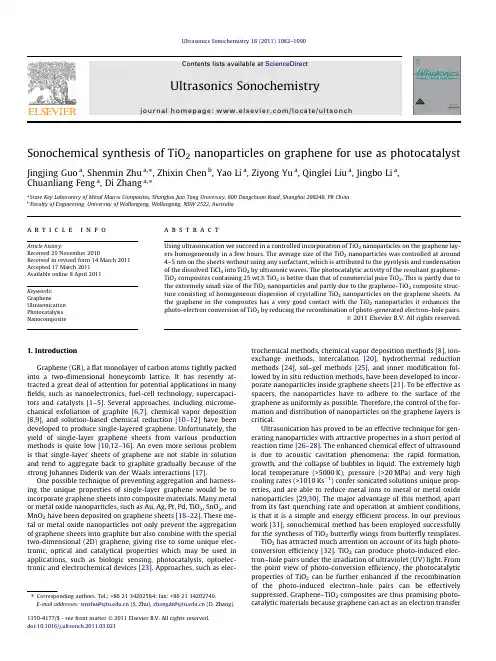
Sonochemical synthesis of TiO 2nanoparticles on graphene for use as photocatalystJingjing Guo a ,Shenmin Zhu a ,⇑,Zhixin Chen b ,Yao Li a ,Ziyong Yu a ,Qinglei Liu a ,Jingbo Li a ,Chuanliang Feng a ,Di Zhang a ,⇑a State Key Laboratory of Metal Matrix Composites,Shanghai Jiao Tong University,800Dongchuan Road,Shanghai 200240,PR China bFaculty of Engineering,University of Wollongong,Wollongong,NSW 2522,Australiaa r t i c l e i n f o Article history:Received 29November 2010Received in revised form 14March 2011Accepted 17March 2011Available online 8April 2011Keywords:GrapheneUltrasonication Photocatalysis Nanocompositea b s t r a c tUsing ultrasonication we succeed in a controlled incorporation of TiO 2nanoparticles on the graphene lay-ers homogeneously in a few hours.The average size of the TiO 2nanoparticles was controlled at around 4–5nm on the sheets without using any surfactant,which is attributed to the pyrolysis and condensation of the dissolved TiCl 4into TiO 2by ultrasonic waves.The photocatalytic activity of the resultant graphene–TiO 2composites containing 25wt.%TiO 2is better than that of commercial pure TiO 2.This is partly due to the extremely small size of the TiO 2nanoparticles and partly due to the graphene–TiO 2composite struc-ture consisting of homogeneous dispersion of crystalline TiO 2nanoparticles on the graphene sheets.As the graphene in the composites has a very good contact with the TiO 2nanoparticles it enhances the photo-electron conversion of TiO 2by reducing the recombination of photo-generated electron–hole pairs.Ó2011Elsevier B.V.All rights reserved.1.IntroductionGraphene (GR),a flat monolayer of carbon atoms tightly packed into a two-dimensional honeycomb lattice.It has recently at-tracted a great deal of attention for potential applications in many fields,such as nanoelectronics,fuel-cell technology,supercapaci-tors and catalysts [1–5].Several approaches,including microme-chanical exfoliation of graphite [6,7],chemical vapor deposition [8,9],and solution-based chemical reduction [10–12]have been developed to produce single-layered graphene.Unfortunately,the yield of single-layer graphene sheets from various production methods is quite low [10,12–16].An even more serious problem is that single-layer sheets of graphene are not stable in solution and tend to aggregate back to graphite gradually because of the strong Johannes Diderik van der Waals interactions [17].One possible technique of preventing aggregation and harness-ing the unique properties of single-layer graphene would be to incorporate graphene sheets into composite materials.Many metal or metal oxide nanoparticles,such as Au,Ag,Pt,Pd,TiO 2,SnO 2,and MnO 2have been deposited on graphene sheets [18–22].These me-tal or metal oxide nanoparticles not only prevent the aggregation of graphene sheets into graphite but also combine with the special two-dimensional (2D)graphene,giving rise to some unique elec-tronic,optical and catalytical properties which may be used in applications,such as biologic sensing,photocatalysis,optoelec-tronic and electrochemical devices [23].Approaches,such as elec-trochemical methods,chemical vapor deposition methods [8],ion-exchange methods,intercalation [20],hydrothermal reduction methods [24],sol–gel methods [25],and inner modification fol-lowed by in situ reduction methods,have been developed to incor-porate nanoparticles inside graphene sheets [21].To be effective as spacers,the nanoparticles have to adhere to the surface of the graphene as uniformly as possible.Therefore,the control of the for-mation and distribution of nanoparticles on the graphene layers is critical.Ultrasonication has proved to be an effective technique for gen-erating nanoparticles with attractive properties in a short period of reaction time [26–28].The enhanced chemical effect of ultrasound is due to acoustic cavitation phenomena:the rapid formation,growth,and the collapse of bubbles in liquid.The extremely high local temperature (>5000K),pressure (>20MPa)and very high cooling rates (>1010Ks À1)confer sonicated solutions unique prop-erties,and are able to reduce metal ions to metal or metal oxide nanoparticles [29,30].The major advantage of this method,apart from its fast quenching rate and operation at ambient conditions,is that it is a simple and energy efficient process.In our previous work [31],sonochemical method has been employed successfully for the synthesis of TiO 2butterfly wings from butterfly templates.TiO 2has attracted much attention on account of its high photo-conversion efficiency [32].TiO 2can produce photo-induced elec-tron–hole pairs under the irradiation of ultraviolet (UV)light.From the point view of photo-conversion efficiency,the photocatalytic properties of TiO 2can be further enhanced if the recombination of the photo-induced electron–hole pairs can be effectively suppressed.Graphene–TiO 2composites are thus promising photo-catalytic materials because graphene can act as an electron transfer1350-4177/$-see front matter Ó2011Elsevier B.V.All rights reserved.doi:10.1016/j.ultsonch.2011.03.021Corresponding authors.Tel.:+862134202584;fax:+862134202749.E-mail addresses:smzhu@ (S.Zhu),zhangdi@ (D.Zhang).channel thus reduces the recombination of the photo-generated electron holes,and leads to improved photo-conversion efficiency [33,34].It was reported that a mixture of commercially pure TiO2 (P25)powder and graphene showed a relatively high photocata-lytic property[24].However,the particle size of P25was relative large and in micrometers and thus the photocatalytic property can be further improved if the size of TiO2is reduced to nanome-ters.In fact,TiO2particle size needs to be reduced down to nanometers in order to improve the photocatalytic activity for liquid-phase oxidation.In this paper,we report a sonochemical method that embeds TiO2nanoparticles into graphene oxide(GO)nanosheets homoge-neously without functionalizing the surface with a surfactant. Graphene–TiO2composite(GR–TiO2)was obtained by chemical reduction of the graphene oxide–TiO2composite(GO–TiO2).The photocatalytic properties of the obtained GR–TiO2composites were investigated by measuring the photo-degradation of methy-lene blue under UV-light,which demonstrated a high photocata-lytic performance for the obtained composites.2.Experimental2.1.Preparation of GOGO was prepared from natural graphite(crystalline,300mesh, Alfa Aesar)by a modified Hummers method[35].The detailed pro-cessing is described as below:2g of graphite and1g of NaNO3 were mixed with46ml of H2SO4(98%)in a250ml wide necked bottle placed in an ice bath.Then,the mixture was stirred for 30min.While maintaining magnetic vigorous stirring,a certain amount of KMnO4(6g)was added to the suspension carefully. After that,the ice bath was replaced by an oil bath,and the mixture was stirred at15°C for2h.As the reaction progressed,the mixture gradually became pasty,and the color turned into light brownish. The next step was to increase the reaction temperature to40°C and keep for another1h.Then,92ml of H2O was slowly added to the pasty mixture with vigorous agitation.The reaction temper-ature was rapidly increased to98°C with effervescence,and the color changed to yellow.Finally,30ml of5%H2O2was added to the mixture and allowing the high-temperature reaction to go on for1h.For purification,the mixture was rinsed and centrifugated with5%HCl and deionized water for several times.Afterfiltration and drying under vacuum at60°C,GO was obtained as a gray powder.2.2.Preparation of GO–TiO2GO–TiO2composite was synthesized by sonochemical reaction of TiCl4in the presence of the GO.The detailed process is described as follows:firstly,TiO2precursors were prepared with the molar ratios of ethanol:H2O:TiCl4=35:11:1,then,0.25g of the GO was added and stirred for0.5h at ambient temperature,andfinally the suspension was sonicated at room temperature for3h using a high-intensity ultrasonic probe(Ti horn,20kHz,100W/cm2). The resulting composite was recovered by centrifugation and rins-ing with ethanol solvent several times,then dried under vacuum at 60°C.The obtained sample is called GO–TiO2.2.3.Preparation of GR–TiO2Chemical conversion of GO–TiO2to GR–TiO2was carried out by using a reduction method[36].In a typical reduction experiment, 0.7g of GO–TiO2powder was dispersed in180ml of deionized water and the mixture was sonicated for1h.Next,24ml of hydra-zine(85%)was added into the mixture under magnetic stirring and stirred for24h at50°C.GR–TiO2composite was obtained byfiltra-tion and drying under vacuum at60°C.After calcination at450°C for3h under nitrogen,crystallized GR–TiO2composite(GR–TiO2–T)was obtained.2.4.Preparation of grapheneGraphene was obtained by chemical conversion of GO according to the literature[36].In a typical reduction experiment,0.5g of GO powder was dispersed in150ml of deionized water and the mix-ture was sonicated for1h.Next,18ml of hydrazine(85%)was added under magnetic stirring,and the mixture was continuously stirred at50°C for24h.Finally,black graphene powder was obtained byfiltration and drying under vacuum at60°C.2.5.CharacterizationThe synthesized samples were characterized by X-ray diffrac-tion(XRD)using a RigakuD/max2550VL/PC system operated at 40kV and40mA with Cu K a radiation(k=1.5406Å),at a scan rate of5°minÀ1and a step size of0.050°in2h.Nitrogen adsorption measurements at77K were performed using an ASAP2020volu-metric adsorption analyzer,after the samples had been outgassed for8h in the degas port of the adsorption apparatus.Field-emis-sion scanning electron microscopy(FE-SEM)was performed on a JEOL JSM-6360LVfield emission microscope at an accelerating voltage of15kV.Transmission electron microscopy(TEM)and en-ergy-dispersive X-ray measurements(EDX)were carried out on a JEOL2010microscope at200kV.TEM specimens were prepared by grinding the synthesized samples into powder with a mortar and pestle and the powder was dispersed in pure ethanol and picked up with holey carbon supportingfilms on copper grids.Fou-rier transform-infrared measurements(FT-IR)were recorded on KBr pellets with a PE Paragon1000spectrophotometer.Thermal gravimetric analysis(TGA)was conducted on a PE TGA-7instru-ment with a heating rate of20°C/min.X-ray photoelectron spectra (XPS)were collected on a physical electronics PHI5400using Mg K a radiation as X-ray source.All the spectra were corrected with the C1s(285.0eV)band.Diffuse reflectance electronic spectra were measured with a Perkin–Elmer330spectrophotometer equipped with a60mm Hitachi integrating sphere accessory.2.6.Photocatalytic experiments30mg of catalyst(GR,TiO2,and GR–TiO2–T)was dispersed in a 40ml0.02g/L aqueous solution of methylene blue dye in a quartz test cell.The reaction system was kept saturated with oxygen by purging a slow stream of oxygen at ambient temperature.Before irradiation,the reactor was stirred constantly in the presence of oxygen in dark for30min,and then irradiated by four UV lamps (6W each)at room temperature.The photocatalytic activity was evaluated on the basis of decrease of the absorbance band of the methylene blue at665nm recorded at a regular time interval fol-lowing the UV illumination.The absorbance measurement of the reaction solution was taken after separating the TiO2from the reaction system by centrifugation.3.Results and discussion3.1.CharacterizationsWide-angle XRD patterns of the pure TiO2,GR,GR–TiO2and GR–TiO2–T are given in Fig.1.The very broad peak at2h=25.5°of GR–TiO2indicates that TiO2in the sample is largely of amor-phous in nature.After the calcination at450°C,this peak atJ.Guo et al./Ultrasonics Sonochemistry18(2011)1082–109010832h=25.5°becomes relatively narrower and resolved,indicating that nanocrystalline TiO2formed on the graphene.However,the peak is still too broad to be used to estimate the size of crystallites with Scherrer equation[37].Nevertheless the broad peak suggests that growth of the nanocrystalline TiO2on the graphene was very limited during the calcinations.The loading of the TiO2nanoparticles on the graphene was determined by performing TGA in air by heating up from40to 900°C(Fig.2).A significant mass loss was observed at tempera-tures from510to700°C for both GR and GR–TiO2–T,due to the destruction of the carbon skeleton(carbonyl/double bond)of graphene.The weight loss of GR–TiO2–T was stabilized at75%atthe graphene sheets in the GR–TiO2–T composite exhibited nano-scale textures,indicative of a much rougher surface(Fig.3b).At a high magnification(Fig.3d),we can clearly see the uniform disper-sion of TiO2nanoparticles on both the graphene surface and the interlayers.There is no agglomeration in the composite as shown in the SEM image of the GR–TiO2sheet(Fig.3f).Fig.3f also shows that the TiO2particle size was in nanometers which will be further characterized by using TEM.Fig.4shows TEM images of TiO2loaded on the graphene layers before(GR–TiO2)and after the calcination at450°C for3h(GR–TiO2–T).For the as-synthesized GR–TiO2(Fig.4a),there are plenty of wrinkles(in circles and at the edge)on the clean sheet owing to the2D nature of the sheet.The edges of the sheets are folded and give the appearance of ribbons.High-magnification TEM micro-graphs(Fig.4b and c)reveal no discrete and well defined nanocrys-talline TiO2particles on the graphene sheets.However EDX(see Supporting Information,Fig.s1)shows the presence of Ti,O and C in the sample.The corresponding selected area electron diffrac-tion pattern(SAED)of the composite shows that diffraction spots of the graphite superimposed with the diffraction rings of TiO2 nanoparticles.After the calcination at450°C for3h,discrete and well defined TiO2fully crystallized particles were uniformly scat-tered on the sheets as shown in Fig.4d and the particle size is around4–5nm from the high resolution image(Fig.4f).This obser-vation is consistent with the wide angle XRD results presented ear-lier(Fig.1).The inset in Fig.4f is the SAED of GR–TiO2–T,and it can be seen that the sample has a clear sixfold pattern of the graphene and the diffraction rings of the TiO2nanoparticles.The existence of elements Ti,O and C was detected by EDX analysis(see Supporting Information Fig.s2).As demonstrated in Fig.4e,the measured lat-tice-fringe spacing of0.34nm in the ribbons corresponds to the (002)of the graphene sheets,where the crystal lattice of TiO2 nanoparticles is also resolved.From Fig.4f the measured lattice fringe spacing of0.355nm in GR–TiO2–T composites corresponds to the(101)of anatase TiO2(JCPDS21-1272).No agglomeration of the TiO2particles was observed in this sample,which is usually observed in samples prepared by other methods[20,24].The TEM images shown in Fig.4confirm that a uniform disper-sion of TiO2nanoparticles on the graphene sheets have been achieved under sonochemical reactions without the use of any sur-factant.Which means ultrasound is very effective in dispersing TiO2nanoparticles on graphene layers.In order to understand the texture of the composites,nitrogen isothermal adsorption technique was employed to investigate the ultrasonic irradiation effect on the pore structure as well as to determine the location of the TiO2in graphene(Fig.5).The shape of the isotherm for GR–TiO2–T was similar to that of the parent GR,indicating the presence of open pores.It has a specific surface area of49m2gÀ1according to the BET(Brunauer,Emmett and Tell-er)analysis.The P/P0position of the inflection points is related to the pore size in mesopore range,and the sharpness of these steps indicates the uniformity[38].As the relative pressure increases, both the isotherms of GR and GR–TiO2–T exhibit sharp inflections in the P/P0in the range0.5–0.6,a characteristic of capillary con-densation within a uniform of interlayer spacing.Interestingly, the space layer distribution of the starting GR centered at2.6nm but disappeared when the TiO2was loaded,suggesting the possi-bility that titanium oxide formedfirst in this interlayer spacing. As a result,the space layer distribution of GR–TiO2–T is more uni-form than that of the pure GR from pore size distributions shown in Fig.5(inset).The metal oxide nanoparticles increased the dis-tance between the GR sheets to several nanometers,thereby mak-ing the both faces of the graphene accessible.The light-absorbance property of the samples was studied with a UV–vis spectrophotometer and the measured UV–visible diffuse reflectance electronic spectra are shown in Fig.6.The absorption 18(2011)1082–1090bands of GR–TiO2–T appeared to be fairly different from that of P25.Because the appearance of TiO2is white whereas the GR–TiO2–T is black,the Kubelka–Munk theory could not apply to this sample with such a strong adsorption.Therefore,the quantitative consideration is void between TiO2and GR–TiO2–T.However,a broad and strong absorption in the visible light region was ob-served for GR–TiO2–T due to the presence of75wt.%GR in the GR–TiO2–T composite which acts as a‘‘dyade’’structure[39].This enhanced light-harvesting intensity of GR–TiO2–T could be possi-bly explained by the formation of the chemical bonding between TiO2and GR,i.e.a Ti–O–C bond which favors charge transfer upon light excitation[40].The formation of the Ti–O–C bond was confirmed by FT-IR spec-troscopy as shown in Fig.7.GO depicts a strong OH peak at 3389.4cmÀ1and other C–O functionalities such as COOH (1726.6cmÀ1)and COC/COH(1383.3–1055.3cmÀ1)are clearly vis-ible.The spectrum also shows a C@C peak at1617.5cmÀ1corre-sponding to the remaining sp2character.After the hydrazine reduction,the characteristic absorption peaks(at1726.6,1383.3–1055.3,and591.2cmÀ1)of GO disappeared due to the reduction of oxygenous groups from the GO.As for GR–TiO2–T,the broad absorptions at low frequencies(below1000cmÀ1)were ascribed to the vibration of Ti–O–Ti bond(671.3,683.9cmÀ1)and Ti–O–C bond(780.2cmÀ1)which was not observed in the spectrum of GR.This demonstrates that the TiO2nanoparticles were strong chemically bonded on the graphene sheets,which was facilitated by the sonochemical reaction.Further it was found that the peak of the stretching vibration C-OH at3419.7cmÀ1of GR shifted to a higher wave number of3443.8cmÀ1for GR–TiO2–T,which could be explained by the influence of the formation of Ti–O–C bond. Similar to that of GR,the skeletal vibration of the GR sheets at 1569.6cmÀ1was also clearly observed for GR–TiO2–T,illustrating the formation of GR–TiO2–T composites.Due to the Ti–O–C bond the TiO2nanoparticles in GR–TiO2–T did not grow much upon cal-cinations,i.e.the host graphene sheet prevented the nanocrystals from sintering.Complicated titanium coordination states in GR–TiO2–T,were revealed from the XPS results.Fig.8a shows the Ti2p XPS spectra of GR–TiO2–T,GR and GO.As expected,there are two peaks,Ti2p3/2 centered at458.5eV and Ti2p1/2at464.2eV in the XPS spectrum of GR–TiO2–T,which were not detected in the spectra of GR and GO.Fig.8b shows the XPS spectra of GR–TiO2–T,GO and GR in the binding energy range between280and294eV(C1s).The two peaks at287and285eV of GO indicate a considerable degree of oxidation of the graphite.The binding energy of285eV is due to non-oxygenated ring C(284.3eV),and287eV is due to the C in C–O bonds(285.2eV),the carbonyl C(C@O,287.4eV)and carboxyl C (COOH,289.1eV)respectively[41].Both the C1s in the XPS spec-tra of GR and GR–TiO2–T exhibit only a single strong peak at 284.3eV which is attributed to elemental carbon,with aweak Fig.3.FE-SEM images of GR(a,c,e)and GR–TiO2–T(b,d,f)in different magnifications.Fig.6.Diffuse reflectance electronic spectra of pure TiO2and GR–TiO2–T.XPS spectra of GO,GR and GR–TiO2–T,(b)the C1s XPS spectra of GO,GR and GR–TiO2–T,(c)the survey XPS spectra of GO,electrostatic binding,or through charge-transfermight become attached to the carboxylto TiO2takes place on the surface of theHowever,the number of ionizable carboxylenough to complex the metal cationsoxide particles formed,resulting in lessparticles.Generally,surface functionaliza-be effective for homogeneous dispersionSB12is generally used to control the sizeprevent aggregation[42].Here in our pro-nanoparticles were formed on the surface of graph-modification or additional agent.The unique ultrasonication may have effects on the formation aggregation of the TiCl4on the surface of the GO sheets can be sig-nificantly retarded by the collapse of small bubbles,resulting in a layer coating,a few nanometers thick,on the GO surface,which is consistent with the disappearance of layer spacing at2.6nm from the BET analysis.As a result,uniform dispersion offine TiO2 forms in situ without any surface functionalization.The one-step formation of the TiO2-graphene composites under ultrasonic irra-diation illustrates the simplicity and efficiency of the sonochemical approach as compared with the commonly used sol–gel’s proce-dure which is generally complex and very time-consuming.3.3.Photocatalytic measurementsThe photocatalytic activities of GR–TiO2–T were measured by the photo-degradation of methylene blue as model reaction under UV-light(6400nm),and the results are shown in Fig.10.For a comparison,the photocatalytic activities of commercial TiO2and pure GR were also measured under the same condition.In order to exclude the influence of adsorption process,a time of60min was allowed to achieve adsorption equilibrium before the photo-catalytic reaction.Fig.10shows that the concentration of methy-lene blue decreases fast with irradiation time both for TiO2and GR–TiO2–T,but almost no concentration change was observed for the pure GR,illustrating that the photocatalytic reaction is related to the existence of active sites(here TiO2).The pseudo-first-order reaction was observed for the both TiO2and GR–TiO2–T(Fig.11). For GR–TiO2–T,the k value at0.0139is higher than that of P25 at0.0054;a high k value is well known to have a high photocata-lytic activity.Photocatalytic efficiency can be affected by three things:crystalline phase,surface area and hierarchical structures. It is also well known that the activity is proportional to the surface area accessible to the liquid.A large surface area could adsorb sig-nificant amounts of water thus hydroxyl groups which can react with photo excited holes and produce hydroxyl radicals which are powerful oxidants in degrading organics.In this investigation, the surface area of GR–TiO2–T was almost the same as that of TiO2but the former showed much higher photocatalytic activity than the latter.This may be explained by the crystalline TiO2nano-particles prepared by sonochemical and calcinations approach, which enhance the activity by facilitating the access to the reactive sites of TiO2.Further,the graphene in the composite can act as an electron transfer channel to reduce the recombination of the photo-generated electron holes,and lead to improved photo-con-version efficiency[33,34].It should be noted that the weight ratio of the TiO2in GR–TiO2–T composite is only25wt.%,so the real9.The proposed TiO2nanoparticles formation mechanism on the graphene sheets by sonochemical method.Fig.10.Photo-degradation of methylene blue solution under UV-light over GR,TiOphotocatalytic activity of the TiO 2nanoparticles should be even higher than commercial pure TiO 2.4.ConclusionsUsing ultrasonication we succeed in controlled incorporation of TiO 2on the graphene layers homogeneously in a few hours.The average particle size of the TiO 2was controlled at around 4–5nm on the sheets without using any surfactant,which is attrib-uted to the pyrolysis and condensation of the dissolved TiCl 4into TiO 2by ultrasonic waves.The synthesis process is simple and effi-cient.The photocatalytic performance of GR–TiO 2–T containing 25wt.%TiO 2is better than commercial pure TiO 2.The much im-proved photocatalytic activity of GR–TiO 2–T,prepared by sono-chemical method,is attributed to the graphene–TiO 2composite structure consisting of very small and homogeneous dispersion of crystal TiO 2on the graphene sheets.In this case the photocata-lytic activity of the TiO 2is enhanced not only by the fine size but also by the graphene which reduces the recombination of photo-generated electron–hole pairs.Thus,such integration of 2D supports with large surface areas,and the highly dispersed nanoparticles,can be an exciting material for use in future nano-technology.These results and other related data demonstrate that this sonochemical method may also be extended to synthesize other metal oxides on graphene sheets,with high performance in many potential applications,such as optical,electrical,catalysis,sensors,and energy conversion devices and so on.AcknowledgmentsThe authors gratefully acknowledge the financial support of this research by the National Science Foundation of China (Nos.51072117,50772067),Shanghai Science and Technology Commit-tee (Nos.06PJ14063,07DJ14001),and Sino-French Project of MOST of China (No.2009DFA52410).We also thank SJTU Instrument Analysis Center for the measurements.Appendix A.Supplementary dataSupplementary data associated with this article can be found,in the online version,at doi:10.1016/j.ultsonch.2011.03.021.References[1]A.K.Geim,K.S.Novoselov,The rise of graphene,Nat.Mater.6(2007)183–191.[2]S.Watcharotone,D.A.Dikin,S.Stankovich,R.Piner,I.Jung,G.H.B.Dommett,G.Evmenenko,S.E.Wu,S.F.Chen,C.P.Liu,S.T.Nguyen,R.S.Ruoff,Graphene–silica composite thin films as transparent conductors,Nano Lett.7(2007)1888–1892.[3]X.Wang,L.J.Zhi,K.Mullen,Transparent,conductive graphene electrodes fordye-sensitized solar cells,Nano Lett.8(2008)323–327.[4]J.C.Meyer,A.K.Geim,M.I.Katsnelson,K.S.Novoselov,T.J.Booth,S.Roth,Thestructure of suspended graphene sheets,Nature 446(2007)60–63.[5]M.Ishigami,J.H.Chen,W.G.Cullen,M.S.Fuhrer, E.D.Williams,Atomicstructure of graphene on SiO 2,Nano Lett.7(2007)1643–1648.[6]K.S.Novoselov,A.K.Geim,S.V.Morozov,D.Jiang,Y.Zhang,S.V.Dubonos,I.V.Grigorieva,A.A.Firsov,Electric field effect in atomically thin carbon films,Science 306(2004)666–669.[7]A.Dato,V.Radmilovic,Z.H.Lee,J.Phillips,M.Frenklach,Substrate-free gas-phase synthesis of graphene sheets,Nano Lett.8(2008)2012–2016.[8]K.S.Kim,Y.Zhao,H.Jang,S.Y.Lee,J.M.Kim,K.S.Kim,J.H.Ahn,P.Kim,J.Y.Choi,B.H.Hong,Large-scale pattern growth of graphene films for stretchable transparent electrodes,Nature 457(2009)706–710.[9]A.Reina,X.T.Jia,J.Ho,D.Nezich,H.B.Son,V.Bulovic,M.S.Dresselhaus,J.Kong,Large area,few-layer graphene films on arbitrary substrates by chemical vapor deposition,Nano Lett.9(2009)30–35.[10]D.Li,M.B.Muller,S.Gilje,R.B.Kaner,G.G.Wallace,Processableaqueous dispersions of graphene nanosheets,Nat.Nanotechnol.3(2008)101–105.[11]S.Park,R.S.Ruoff,Chemical methods for the production of graphenes,Nat.Nanotechnol.4(2009)217–224.[12]S.Stankovich,D.A.Dikin,R.D.Piner,K.A.Kohlhaas,A.Kleinhammes,Y.Jia,Y.Wu,S.T.Nguyen,R.S.Ruoff,Synthesis of graphene-based nanosheets via chemical reduction of exfoliated graphite oxide,Carbon 45(2007)1558–1565.[13]Y.Hernandez,V.Nicolosi,M.Lotya,F.M.Blighe,Z.Y.Sun,S.De,I.T.McGovern,B.Holland,M.Byrne,Y.K.Gun’ko,J.J.Boland,P.Niraj,G.Duesberg,S.Krishnamurthy,R.Goodhue,J.Hutchison,V.Scardaci, A.C.Ferrari,J.N.Coleman,High-yield production of graphene by liquid-phase exfoliation of graphite,Nat.Nanotechnol.3(2008)563–568.[14]hravathi,M.Rajamathi,Chemically modified graphene sheets producedby the solvothermal reduction of colloidal dispersions of graphite oxide,Carbon 46(2008)1994–1998.[15]K.S.Novoselov, A.K.Geim,S.V.Morozov, D.Jiang,M.I.Katsnelson,I.V.Grigorieva,S.V.Dubonos,A.A.Firsov,Two-dimensional gas of massless Dirac fermions in graphene,Nature 438(2005)197–200.[16]P.W.Sutter,J.I.Flege,E.A.Sutter,Epitaxial graphene on ruthenium,Nat.Mater.7(2008)406–411.[17]D.F.Leigh,C.Norenberg,D.Cattaneo,J.H.G.Owen,K.Porfyrakis,A.L.Bassi,A.Ardavan,G.A.D.Briggs,Self-assembly of trimetallic nitride template fullerenes on surfaces studied by STM,Surf.Sci.601(2007)2750–2755.[18]R.Muszynski,B.Seger,P.V.Kamat,Decorating graphene sheets with goldnanoparticles,J.Phys.Chem.C 112(2008)5263–5266.[19]C.Xu,X.Wang,J.W.Zhu,Graphene-metal particle nanocomposites,J.Phys.Chem.C 112(2008)19841–19845.[20]G.Williams, B.Seger,P.V.Kamat,TiO 2–graphene nanocomposites UV-assisted photocatalytic reduction of graphene oxide,ACS Nano 2(2008)1487–1491.[21]T.Cassagneau,J.H.Fendler,Preparation and layer-by-layer self-assembly ofsilver nanoparticles capped by graphite oxide nanosheets,J.Phys.Chem.B 103(1999)1789–1793.[22]Y.C.Si, E.T.Samulski,Exfoliated graphene separated by platinumnanoparticles,Chem.Mater.20(2008)6792–6797.[23]C.Xu,X.Wang,Fabrication of flexible metal-nanoparticte film using grapheneoxide sheets as substrates,Small 5(2009)2212–2217.[24]H.Zhang,X.J.Lv,Y.M.Li,Y.Wang,J.H.Li,P25–graphene composite as a highperformance photocatalyst,ACS Nano 4(2010)380–386.[25]X.Y.Zhang,H.P.Li,X.L.Cui,Y.H.Lin,Graphene/TiO 2nanocomposites:synthesis,characterization and application in hydrogen evolution from water photocatalytic splitting,J.Mater.Chem.20(2010)2801–2806.[26]J.C.Yu,J.G.Yu,W.K.Ho,L.Z.Zhang,Preparation of highly photocatalytic activenano-sized TiO 2particles via ultrasonic irradiation,mun.(2001)1942–1943.[27]G.A.Tai,W.L.Guo,Sonochemistry-assisted microwave synthesis and opticalstudy of single-crystalline US nanoflowers,Ultrason.Sonochem.15(2008)350–356.[28]A.Gedanken,Using sonochemistry for the fabrication of nanomaterials,Ultrason.Sonochem.11(2004)47–55.[29]A.Gedanken,X.H.Tang,Y.Q.Wang,N.Perkas,Y.Koltypin,ndau,L.Vradman,M.Herskowitz,Using sonochemical methods for the preparation of mesoporous materials and for the deposition of catalysts into the mesopores,Chem.-Eur.J.7(2001)4546–4552.[30]W.Chen,W.P.Cai,C.H.Liang,L.D.Zhang,Synthesis of gold nanoparticlesdispersed within pores of mesoporous silica induced by ultrasonic irradiation and its characterization,Mater.Res.Bull.36(2001)335–342.[31]S.M.Zhu,D.Zhang,J.J.Gu,J.Q.Xu,J.P.Dong,J.L.Li,Biotemplate fabrication ofSnO 2nanotubular materials by a sonochemical method for gas sensors,J.Nanopart.Res.12(2010)1389–1400.Fig.11.Kinetic plots based on the data of Fig.10.18(2011)1082–10901089。
